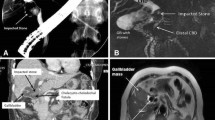Abstract
Background
Mirizzi syndrome and cholecystoenteric fistula with or without gallstone ileus are late complications of gallstone disease. We previously suggested that the natural history of Mirizzi syndrome may not end with just a cholecystobiliary fistula and that the continuous inflammation in the triangle of Calot area may result in a complex fistula involving the biliary tract and the adjacent viscera. The purpose of this study was to establish the relationship of Mirizzi syndrome with cholecystoenteric fistulas.
Methods
We retrospectively reviewed the records of all patients older than aged 18 years submitted to emergency or elective cholecystectomy from 1995 to 2006. Of 5,673 cholecystectomies performed during that period, we found 327 (5.7%) patients with Mirizzi syndrome and 105 (1.8%) patients with cholecystoenteric fistula. Ninety-four (89.5%) patients with cholecystoenteric fistula also had an associated Mirizzi syndrome.
Results
Cholecystoenteric fistula was associated with Mirizzi syndrome (p < 0.0001), increased age was associated with Mirizzi syndrome and cholecystoenteric fistula (p < 0.0001), and female gender was associated with Mirizzi syndrome (p < 0.0001).
Conclusion
When during surgery for gallstone disease a cholecystoenteric fistula is encountered, the possibility of an associated Mirizzi syndrome must be considered. The findings of this study confirm the association of Mirizzi syndrome with cholecystoenteric fistula.





Similar content being viewed by others
References
Abou-Saif A, Al-Kawas FH (2002) Complications of gallstone disease: Mirizzi syndrome, cholecystocholedocal fistula, and gallstone ileus. Am J Gastroenterol 97:249–254
Beltran MA, Csendes A (2005) Mirizzi syndrome and gallstone ileus: an unusual presentation of gallstone disease. J Gastrointest Surg 9:686–689
Özdemír A, Atli MY, Coskun T, Özenc A, Hersek E (1997) Biliary enteric fistulas. Int Surg 82:280–283
McSherry CK, Ferstenberg H, Virshup M (1982) The Mirizzi syndrome: Suggested classification and surgical therapy. Surg Gastroenterol 1:219–225
Csendes A, Diaz JC, Burdiles P, Maluenda F, Nava O (1989) Mirizzi syndrome and cholecystobiliary fistula: a unifying classification. Br J Surg 76:1139–1143
Csendes A, Muñoz C, Albán M (2007) Síndrome de Mirizzi—Fístula colecistobiliar, una nueva clasificación. Rev Chil Cir 59(Suppl):63–64
Johnson LW, Sehon JK, Lee WC, Zibari GB, McDonald JC (2001) Mirizzi’s syndrome: experience from a multi-institutional review. Am Surg 67:11–14
Schäfer M, Schneiter R, Krähenbühl L (2003) Incidence and management of Mirizzi syndrome during laparoscopic cholecystectomy. Surg Endosc 17:1186–1190
Mithani R, Schwesinger WH, Bingener J, Sirinek R, Gross GWW (2008) The Mirizzi syndrome: multidisciplinary management promotes optimal outcomes. J Gastrointest Surg 12:1022–1028
Cortes MR, Vasquez AG (2003) Frequency of the Mirizzi syndrome in a teaching hospital. Cir Gen 25:334–337
Masannat Y, Masannat Y, Shatnawei A (2006) Gallstone ileus: a review. Mount Sinai J Med 73:1132–1134
Chatzoulis G, Kaltsas A, Danilidis L, Dimitrou J, Pachiadakis I (2007) Mirizzi syndrome type IV associated with cholecystocolic fistula: a very rare condition: report of a case. BMC Surg 7:6
Pavlidis TE, Atmatzidis KS, Papaziogas BT, Papaziogas TB (2003) Management of gallstone ileus. J Hepatobiliary Pancreat Surg 10:299–302
Doko M, Zovak M, Kopljar M, Glavan E, Ljubicic N, Hochstädter H (2003) Comparison of surgical treatment of gallstone ileus: preliminary report. World J Surg 27:400–404
Heuman R, Sjödahl R, Wetterfors J (1980) Gallstone ileus: an analysis of 20 patients. World J Surg 4:595–600
Clavien PA, Richon J, Burgan S, Rohner A (1990) Gallstone ileus. Br J Surg 77:737–742
Karademir S, Astarcioglu H, Sökmen S, Atila K, Tankurt E, Akpinar H, Coker A, Astarcioglu I (2000) Mirizzi’s syndrome: diagnostic and surgical considerations. J Hepatobiliary Pancreat Surg 7:72–77
Al-Akeely MHA, Alam MK, Bismar HA, Khalid K, Al-Teimi I, Al-Dossary NF (2005) Mirizzi syndrome: ten years experience from a teaching hospital in Riyadh. World J Surg 29:1687–1692
Desai DC, Smink RD (1997) Mirizzi syndrome type II: is laparoscopic cholecystectomy justified? J Soc Lap Surg 1:237–239
Rohatgi A, Singh KK (2006) Mirizzi syndrome: laparoscopic management by subtotal cholecystectomy. Surg Endosc 20:1477–1481
Author information
Authors and Affiliations
Corresponding author
Rights and permissions
About this article
Cite this article
Beltran, M.A., Csendes, A. & Cruces, K.S. The Relationship of Mirizzi Syndrome and Cholecystoenteric Fistula: Validation of a Modified Classification. World J Surg 32, 2237–2243 (2008). https://doi.org/10.1007/s00268-008-9660-3
Published:
Issue Date:
DOI: https://doi.org/10.1007/s00268-008-9660-3




